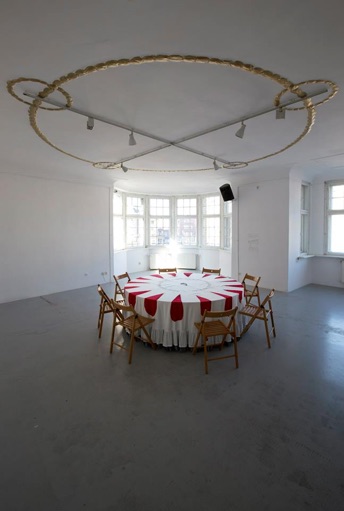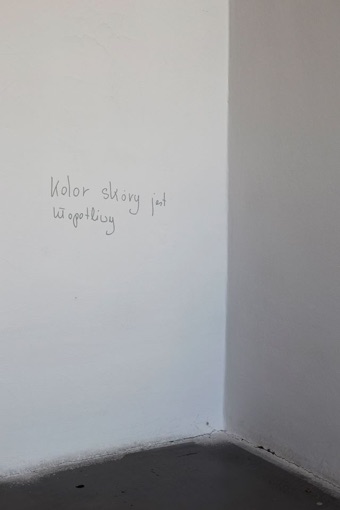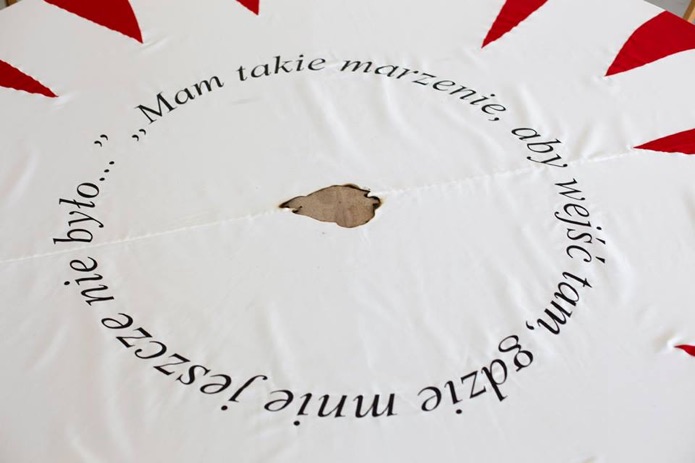Where I was Not
2013-14, tablecloth, table, chairs, wall print)
This work is a result of a 16 month collaboration between Magda Fabiańczyk and members of a Roma community from the post-industrial city Bytom, in Poland. The project was preceded with an extensive research period around Upper Silesia. The first meeting, initiated by CSW Kronika, took place at Primary School No. 16, where Magda met Angela Mirga-Piotrowska – a local Roma woman, and Agata Kołodziejczyk, who led the school’s Romani Club. Angela introduced the artist to the intimate environment of the Bobrek district, one of the economically poorest in Bytom. She acted as a ‘guide’ for Magda, facilitating meetings with Roma in their flats, and later Angela became a co-creator of the project. Conversations and exchange of experiences gave the project its direction. The artist focused on the existing relations between Roma and non-Roma in Poland, ‘uncovering cracks and distortions, turning our attention towards what was hidden or invisible, what one would like to forget’ (Tecl-Szubert, 2014).
Inspired by the entrepreneurial role of women in the Roma community from Bobrek, the table cloth in ‘Where I Was Not’, refers back to a traditional Roma skirt – sewn on a circular plan, and which now only exists as a relic. The color and shape on the tablecloth is informed by both the Romani and Polish flags – although the first record of the presence of Roma in Poland dates back to the 14th century, Roma people are often perceived separately, as ‘other'. The central element of the tablecloth are the words 'I would like to enter, where I have not been yet', originally spoken by Mirga-Piotrowska these words raise that the presence of Roma in Poland is defined by invisible borders. The stigmatising of stereotypes around Roma people means that when going to a match or a disco, they can become the target of an attack. The burnt hole in the middle of the tablecloth is a symbolic reference to one such attack. The table covered with a tablecloth became a meeting place for the Roma people to share dialogues with representatives of the city’s authorities, during which they attempted to work out strategies to counteract existing stigmatization. In the following years, the tablecloth served as a place of debate in other art institutions, both in Poland and abroad, including at the Museum of Roma Culture in Brno.
The workshop with Roma and non-Roma children from Primary School No.16 in Bytom Bobrek was held as part of ‘Where I was Not’ project. The words of these children have become part of the installation.
The project was realised in collaboration with Angela Mirga-Piotrowska, with support from Agata Kołodziejczyk, Agata Tecl- Szubert and Martyna Tec-Reibel, initiated by CSW Kronika and the Imago Mundi Foundation artist residence program in Upper Silesia and the Dąbrowa Basin.
Tam, gdzie mnie nie było
2013 - 2014 (obrus, stół, krzesła, druk naścienny – ploter)
Dzieło jest wynikiem ponad rocznej współpracy Magdy Fabiańczyk z przedstawicielami społeczności romskiej w postindustrialnym Bytomiu na Górnym Śląsku, poprzedzonej badaniami. Pierwsze, zainicjowane przez CSW Kronika spotkanie, odbyło się w Szkole Podstawowej Nr 16, gdzie Fabiańczyk poznała Romkę - Angelę Mirgę-Piotrowską oraz prowadzącą Świetlicę Romską - Agatę Kołodziejczyk. Angela stała się "przewodniczką", a później współtwórczynią projektu, wprowadzając artystkę w intymne środowisko dzielnicy Bobrek, jednej z najuboższych ekonomicznie w Bytomiu, umożliwiając spotkania z romskimi mieszkańcami dzielnicy w ich domach. Rozmowy i wymiana doświadczeń nadały kierunek pracy artystycznej, która skupiając się na teraźniejszych relacjach pomiędzy Romami i nie-Romami, ukazała w nich „pęknięcia i wypaczenia, zwracając uwagę na to, co ukryte, niewidzialne, o czym chciałoby się zapomnieć” (Tecl-Szubert, 2014).
Obrus, zainspirowany przedsiębiorczą rolą kobiet w romskiej społeczności z Bobrka, odnosi się do tradycyjnej romskiej spódnicy uszytej na planie koła, a istniejącej obecnie jako relikt. Kolorem i kształtem nawiązuje zarówno do flagi romskiej, jak i polskiej – chociaż pierwszy zapis o obecności Romów w Polsce sięga XIV w. to często postrzegani są jako "obcy". Centralnym elementem obrusu są słowa Mirgi-Piotrowskiej: "Chciałabym wejść tam, gdzie mnie jeszcze nie było" - przestrzeń funkcjonowania Romów w Polsce określona jest niewidzialnymi granicami. Stygmatyzujące stereotypy sprawiają, że idąc na mecz czy dyskotekę, mogą stać się celem ataku. Wypalona dziura na środku obrusu jest symbolicznym nawiązaniem do jednego z tych wydarzeń. Przykryty obrusem stół stał się realnym miejscem spotkania Romów z przedstawicielami organów władzy w mieście, podczas którego starano się wypracować strategie przeciwdziałania stereotypom. W kolejnych latach obrus posłużył jako miejsce debaty w innych placówkach artystycznych, zarówno w Polsce jak i za granicą, m. in. w Muzeum Romskim w Brnie.
W ramach projektu Tam, gdzie mnie nie było odbyły się również zajęcia z dziećmi romskimi i nie-romskimi w Szkole Podstawowej nr 16 w Bytomiu Bobrku. Zapisane słowa dzieci stały się częścią instalacji.
Projekt został zrealizowany we współpracy z Angelą Mirgą-Piotrowską, Agatą Kołodziejczyk, Agatą Tecl-Szubert oraz Martyną Tecl-Reibel. Praca powstała podczas rezydencji artystycznej na terenie Górnego Śląska i Zagłębia Dąbrowskiego, jako projekt CSW Kronika oraz Fundacji Imago Mundi.


